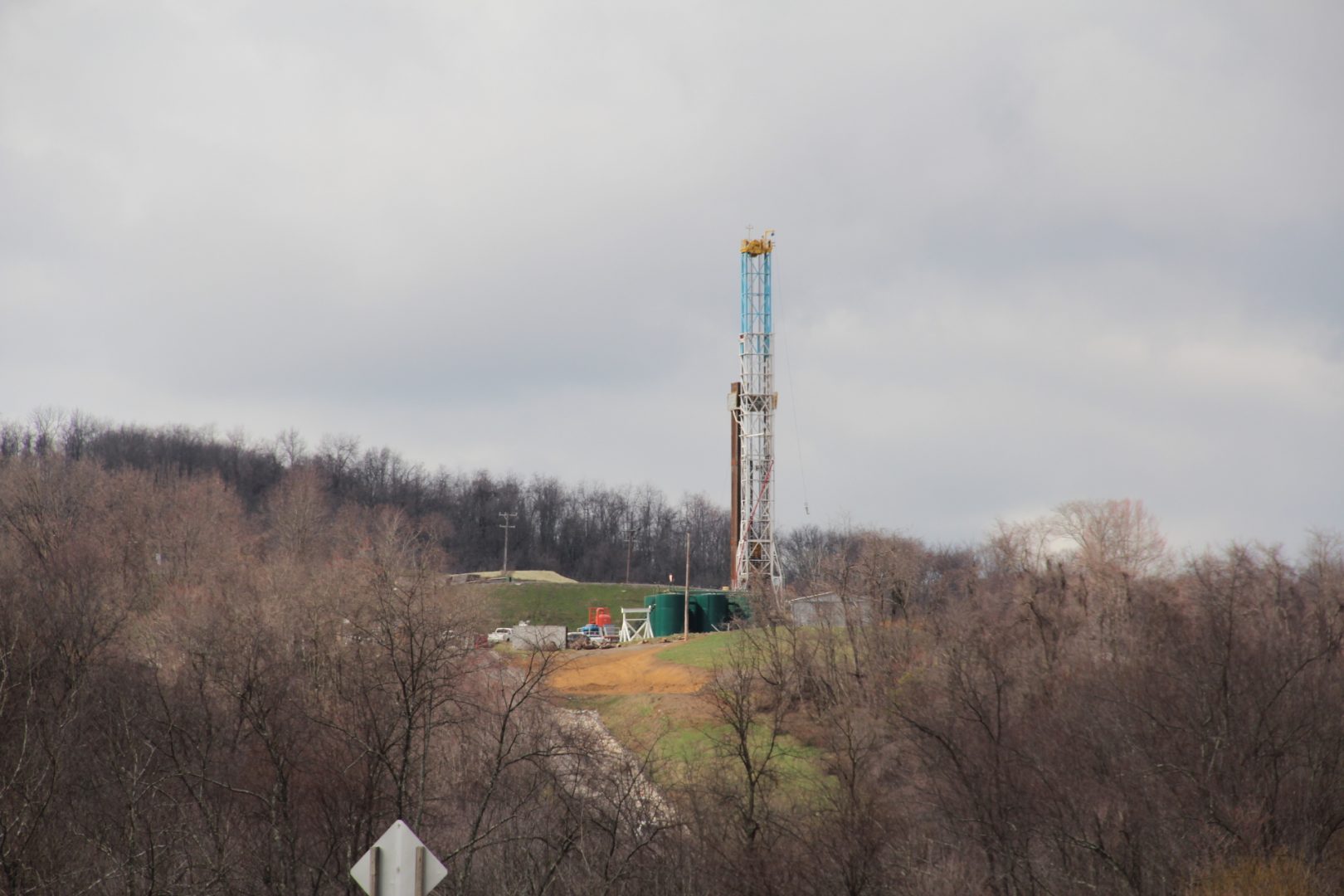
A natural gas drilling rig in Greene County, Pa. in 2016.
Reid R. Frazier / StateImpact Pennsylvania


A natural gas drilling rig in Greene County, Pa. in 2016.
Reid R. Frazier / StateImpact Pennsylvania

Reid R. Frazier / StateImpact Pennsylvania
A natural gas drilling rig in Greene County, Pa. in 2016.
The amount communities get to help offset the effects of natural gas drilling will likely be one of the lowest on record.
A report from the state’s Independent Fiscal Office estimates drillers owe $174 million in impact fees for 2023. The IFO says that’s an effective tax rate of 2.5%.
It’s about $100 million less than the previous year, a 37% drop. In 2022, drillers paid a record $278 million because of a spike in gas prices.
Most years have seen the impact fee raise more than $200 million. The outliers are $146 million in 2020, $173 million in 2016, and $187 million in 2015.
Most of the money goes to communities where drilling happens, to be used for public infrastructure, emergency preparedness, public safety, and other uses. Some money goes to the Marcellus Legacy Fund for projects such as abandoned mine drainage abatement, abandoned well plugging, trails and recreation, watershed restoration, and flood control.
Drillers pay an impact fee for each well they own. The amount depends on the average cost of natural gas and the age of the well.
Gas prices on the New York Mercantile Exchange, the standard for determining the impact fee, plunged nearly 60% last year.
The IFO says there were fewer new wells drilled in 2023 than any year since the impact fee started.
Though companies drilled fewer wells, the amount of gas pulled from the ground remained fairly steady. The Department of Environmental Protection’s 2022 Oil and Gas Annual Report shows drillers produced 7.5 trillion cubic feet of gas, down from 7.6 trillion cubic feet in 2021.
The impact fee differs from a severance tax, which would charge drillers based on the volume of gas produced. The state House passed a resolution in June to study severance tax structures in other major gas-producing states. Advocates for a severance tax have argued it could provide more, and more stable, revenue for the state. Industry has staunchly opposed a severance tax.
The Marcellus Shale Coalition noted the impact fee has raised nearly $2.7 billion since 2012.
“While impact fee returns fluctuate alongside the natural gas market – which, like all other commodities, is cyclical and dependent on a variety of factors – Pennsylvanians are reaping the benefits of our natural gas abundance in the form of lower energy prices, cleaner air and significant economic benefits to the tune of $40 billion in 2022 alone,” said MSC president David Callahan.
The $40 billion figure comes from a report done for MSC by FTI Consulting. It’s the combination of direct investments by industry, as well as estimated indirect and induced effects.
Callahan said policymakers should prioritize increasing production and supporting infrastructure to move the gas to market.
However, Gov. Josh Shapiro has heard from people who say he should be tougher on the fracking industry because of health problems associated with drilling. He recently made an agreement with CNX for that company to follow recommendations from a grand jury report on fracking, as a way of studying the industry’s impact.
The oil and gas sector accounts for nearly 30 percent of all methane emissions in the U.S., according to the Environmental Protection Agency.
Methane is the main component of natural gas and is considered a “super pollutant” because it warms the planet much faster than carbon dioxide. Even though it lasts less time in the atmosphere than CO2, methane is better at trapping heat.
Pennsylvania has set rules for methane leaks at new and existing unconventional well sites. New federal standards are forthcoming.
Pennsylvania’s attempt to join the Regional Greenhouse Gas Initiative to regulate carbon dioxide emissions from power plants, including ones that burn natural gas, has been stopped by a state court.
StateImpact Pennsylvania is a collaboration among WITF, WHYY, and the Allegheny Front. Reporters Reid Frazier, Rachel McDevitt and Susan Phillips cover the commonwealth’s energy economy. Read their reports on this site, and hear them on public radio stations across Pennsylvania.
(listed by story count)
StateImpact Pennsylvania is a collaboration among WITF, WHYY, and the Allegheny Front. Reporters Reid Frazier, Rachel McDevitt and Susan Phillips cover the commonwealth’s energy economy. Read their reports on this site, and hear them on public radio stations across Pennsylvania.
Climate Solutions, a collaboration of news organizations, educational institutions and a theater company, uses engagement, education and storytelling to help central Pennsylvanians toward climate change literacy, resilience and adaptation. Our work will amplify how people are finding solutions to the challenges presented by a warming world.